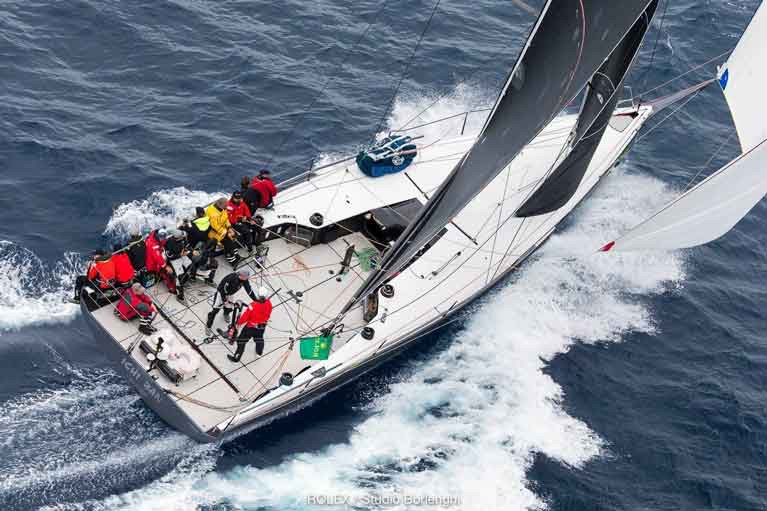In Australia, the unprecedented heatwave is so totally engulfing the continent that respected observers of maritime weather patterns such as Matt Allen, owner/skipper of the very special Botin-designed TP52 development Ichi Ban 2, reckon that we’ll have to be a few days nearer the start of the 75th Rolex Sydney-Hobart Race next Thursday before anyone can begin to predict wind and weather movements with any real degree of accuracy.
Allen – whose dynamic symbiosis with his sailing master Gordon Maguire is one of the most successful partnerships of world sailing – is reckoned to have the boat which is the best all-round bet to take the Tattersall’s Cup for the overall IRC win - the “real sailors” Hobart prize.
The Allen/Maguire team certainly have form and then some, as Ichi Ban 2 was tops in the Tattersall’s in 2017, and in 2018 she was right on to do it again, but sat in that agonizing total calm of night for which Hobart’s Derwent River is notorious for just long enough for the trophy to go to Tasmania’s own RP 66 Alive (Philip Turner), with Ichi Ban finally gliding across in a zephyr to take second.
 The Tasmanian-owned RP 66 Alive became a local hero after narrowly winning the 2018 Rolex Sydney-Hobart Race from Ichi Ban 2.
The Tasmanian-owned RP 66 Alive became a local hero after narrowly winning the 2018 Rolex Sydney-Hobart Race from Ichi Ban 2.
Alive’s win was a local hero success which has spurred the Tasmanian authorities to much more positive moves to make the best of their association with this classic 628 mile offshore race. And at the moment Tasmania certainly looks like the promised land as a destination, as it’s significantly cooler than the mainland. Meanwhile, to the north in New South Wales, what with exploding bush fires and exceptional heatwaves, Sydney actually finds itself at the heart of a region which has declared a State of Emergency.
Quite what happens when you try to get a major event under way in a place which is under a State of Emergency would be a new area of experience for many sporting organisations. But the nature of the Sydney-Hobart Race is such that going ahead with it regardless is surely the best thing that the Cruising Yacht Club of Australia can do in the circumstances.
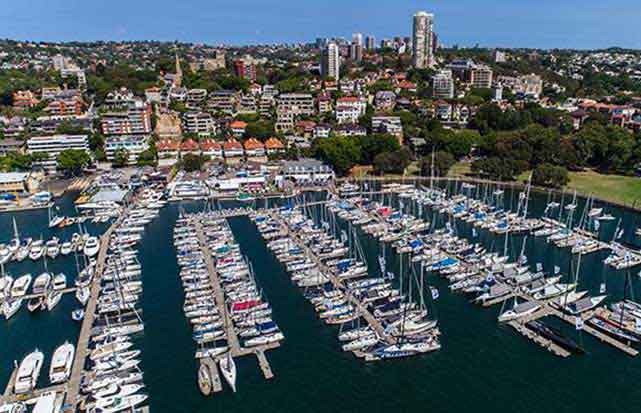 Thee Cruising Yacht Club of Australia’s clubhouse/marina complex at Rushcutter’s Bay on Sydney Harbour
Thee Cruising Yacht Club of Australia’s clubhouse/marina complex at Rushcutter’s Bay on Sydney Harbour
Those circumstances are something that we in the Northern Hemisphere can only wonder at, what with Storm Elsa doing her December best to obliterate Galway City on Wednesday night, and the real prospect of some savagely wintry weather in the run-in to Christmas.
But be of good cheer. Tomorrow (Sunday) at 04:19 UTC, the Winter Solstice 2019 will take place. Despite the battering and abuse that poor old Planet Earth is taking from the most aggressive and destructive species that has ever inhabited it during its billions of years of evolving and developing in the unique way which eventually enabled the complex but sometimes brutal animal which is mankind to come into being, tomorrow this extraordinary life-giving phenomenon takes place yet again.
In the small hours, the barely measurable mid-winter wobbling will start to show a distinct tendency to make the accelerating alteration which will mean that here in the Northern Hemisphere, our time of natural daylight will at last start to increase again, and most of us will be grateful for it.
We know there’s a bit of a wobble (or whatever you want to call it), because for a few days the dawn continues to arrive later, yet the sunset starts to come later too. Nowadays, with universal and excessive electrical light, all this may seem less important. But time was when people who were impatient for Spring to arrive avidly followed each evening’s marginal lengthening of the daylight.
One such was the genius American yacht designer and builder Nathanael Greene Herreshoff (1848-1938), a martyr to rheumatism who craved the sun. His exceptional creativity is celebrated in the Herreshoff Marine Museum in Bristol, Rhode Island. There, it’s mind blowing to contemplate the variety and achievement of Herreshoff’s many designs. But one homely little exhibit which I particularly recall from a visit more than twenty years ago is a special piece of wall-paper.
 Genius pushed to the limit……while Nathanael Herreshoff designed and built many sensible and seaworthy vessels, when required he could push yacht design and construction to the limits and beyond, and his successful America’s Cup defender Reliance of 1903 was one of the most extreme racing machines ever to be involved in the AC.
Genius pushed to the limit……while Nathanael Herreshoff designed and built many sensible and seaworthy vessels, when required he could push yacht design and construction to the limits and beyond, and his successful America’s Cup defender Reliance of 1903 was one of the most extreme racing machines ever to be involved in the AC.
Apparently it had been in a west-facing room in the Herreshoff homestead, and when Mrs Herreshoff had that room re-decorated, the new wall-paper in the reveal of the main window provided enough clear space between its decorations for Captain Nat to conveniently record (in pencil if I remember rightly) the slow but sure progress of the sunset to the north, noting for instance that on some date in April, the sun set for the first time to the north of the Adams’s barn or some such ad hoc marker.
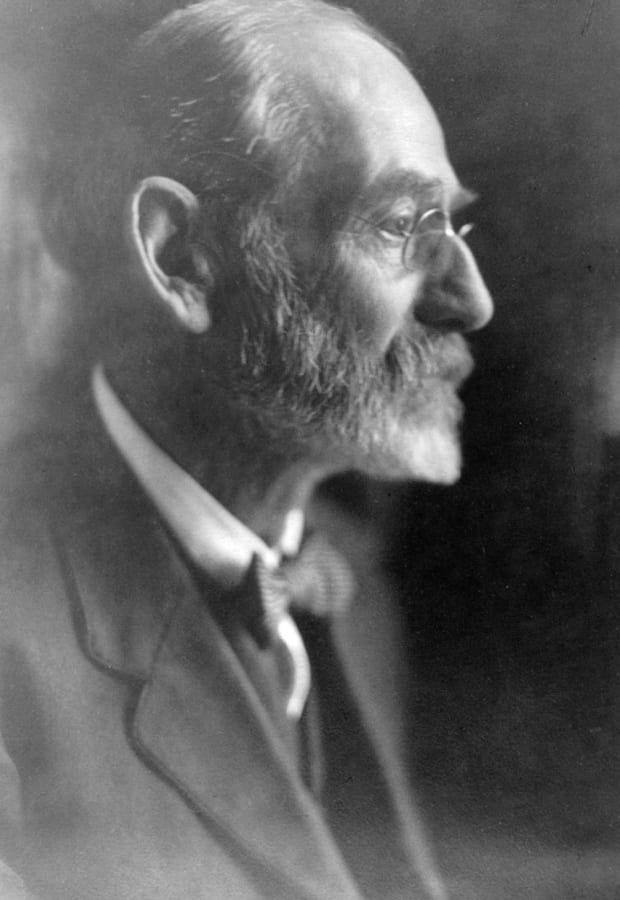 Nathanel Greene Herreshoff, the “Wizard of Bristol”. He so craved daylight and sunshine that he used newly-fitted wallpaper to keep a record of the advancing time of sunset at his home. Despite chronic illness and working himself to the edge of breakdown in expanding his family’s boat-building firm, he lived to the age of 90.
Nathanel Greene Herreshoff, the “Wizard of Bristol”. He so craved daylight and sunshine that he used newly-fitted wallpaper to keep a record of the advancing time of sunset at his home. Despite chronic illness and working himself to the edge of breakdown in expanding his family’s boat-building firm, he lived to the age of 90.
Quite what Mrs Herreshoff made of the great man’s disfigurement of her new wallpaper we can only guess. But we can understand his own need for encouragement. Yet today we find that the dark days are by-passed, such that the current focus of Irish sailing this weekend is almost entirely on the Southern Hemisphere and Australia, despite heatwaves and States of Emergency.
Edward Bransfield of Ballinacurra
In a year in which the pioneering achievements of seagoing explorer and Antarctic discoverer Edward Bransfield of Ballinacurra in East Cork have finally been given a tangible memorial in his home place (encouraged and reported by Tom MacSweeney of this parish) in time for the Bicentenary of his discovery of Antarctica in 1820, perhaps we find ourselves in the northern winter solstice thinking more than we should be of sailing under the sun of the southern hemisphere.
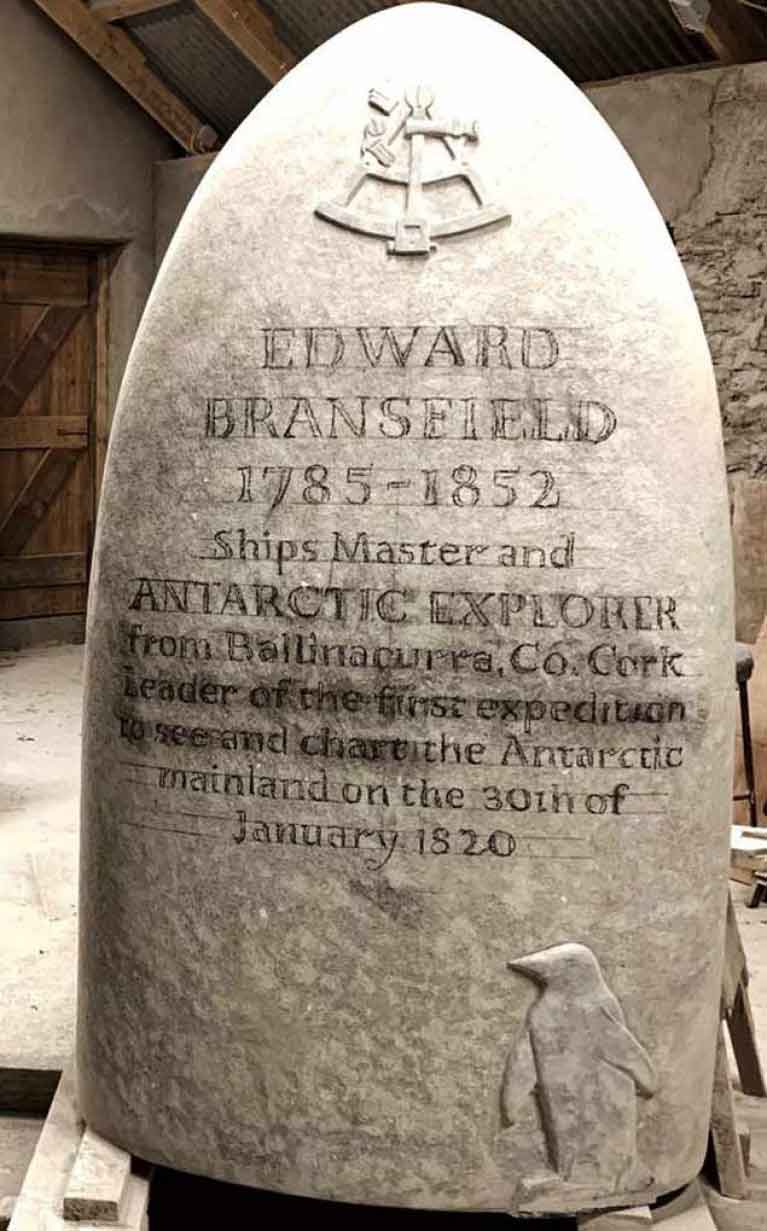 Southern Hemisphere plus……the Bransfield Memorial at Ballinacurra, sculpted by Matt Thompson, will commemorate the discoverer of the Antarctic continental landmass in 1820. Photo: Tony Whelan
Southern Hemisphere plus……the Bransfield Memorial at Ballinacurra, sculpted by Matt Thompson, will commemorate the discoverer of the Antarctic continental landmass in 1820. Photo: Tony Whelan
But when we remember that Bransfield’s ultimately successful seafaring career began with being forcibly enlisted at the age of 18 by a Royal Navy press gang rapaciously kidnapping any able-bodied men they could find in the pleasant farmland of East Cork, there’s food for thought. Indeed, there’s at least an academic study and maybe a book on the “beneficial” effects on what is now claimed to be Irish maritime history by the recruiting methods of the Human Resources Department of the Royal Navy during the Napoleonic wars.
For although Bransfield eventually became a successful part of the system which had so ruthlessly torn him away from home, rising to become a ship’s captain and achieving the ultimate respectability of retiring not to Ballinacurra but to Brighton, there were others who always dreamed of getting out of enforced naval service, or at least following a different path a sea.
One such was William Brown of Foxford in Mayo. His story is complex, but while serving in the American navy he was press-ganged into the Royal Navy, yet escaped by scuttling the ship in which he was unwillingly serving. Eventually he ended up in Argentina and when war broke out with Spain, he was instrumental in creating the Argentine navy, with which - as Almirante Brown – his founding role continues to be celebrated today, most notably in Argentina by having several warships recalling him over the years, and no less than four football clubs named in his honour.
 You need to go into the Southern Hemisphere for a uniform like this – Admiral William Brown of Foxford, County Mayo, founder of the Argentine Navy.
You need to go into the Southern Hemisphere for a uniform like this – Admiral William Brown of Foxford, County Mayo, founder of the Argentine Navy. The Argentine Navy’s destroyer Almirante Brown is the latest ship to be named after the Mayo-born founder
The Argentine Navy’s destroyer Almirante Brown is the latest ship to be named after the Mayo-born founder
It’s the latter honour which would be most readily appreciated in sports-mad Australia, where there’s no doubting the sense of bewilderment as the weather goes crazy with hyper-heatwaves, and the incomparable Sydney Harbour – usually bright and pristine at this height of summer – is spending much of its time obscured in haze which may thicken to smoke from the tens of thousands of acres of bush fires around the city.
Smoke obscured Sydney Harbour
Nevertheless in and around the famous if sometimes smoke-obscured harbour, there’s an impressive fleet of 164 boats in the final stages of preparation for the 75th Rolex Sydney-Hobart Race As it happens, this turnout is large by modern standards, but that’s because today’s safety standards are much more rigorous, whereas in the early races, as 1950’s overall winner Jim Hardy recalls, doing the Hobart Race in those days didn’t even require guard-rails, while an emergency medical kit consisted of an extra package of bandages…..
Thus the fleet for the 75th RSHR is the fourth biggest in the race’s history but is much bigger than the 100-120 numbers which have been raced in recent years. Last week, we looked at the boats of Irish interest in the fleet, and the word now is that the First 40 HYC Breakthrough has successfully completed her mandatory 24 hours of offshore sailing, and she and her ship’s complement are now totally RSHR-compliant.
 The First 40 HYC Breakthrough (Darren Wright) returning to the CYCA marina yesterday in total heatwave conditions after completing her mandatory RSHR 24 hours offshore in the Tasman Sea. Photo: Judith Malcolm
The First 40 HYC Breakthrough (Darren Wright) returning to the CYCA marina yesterday in total heatwave conditions after completing her mandatory RSHR 24 hours offshore in the Tasman Sea. Photo: Judith Malcolm
It has been a length process organised by sailing master Kieran Jameson, and though it started as a bareboat charter, for the duration of the race HYC Breakthrough will actually be registered as owned by Darren Wright, which is a decidedly thorough way of going at the challenge.
In fact, the Wright effect has been much in evidence in Sydney sailing this past week, as Darren’s son Rocco – already noted as one of Ireland’s leading Optimist sailors – milled his way through the local opposition in the Sydney Sailing series to such good effect in the Open Optimist Class that at the competition’s completion, he was discarding a second.
It’s not something to be dismissed lightly, as the sailors he bested included one with the surname of Beashel, and around Sydney Harbour, the Beashel family are dinghy sailing royalty. Further to build on the Wright effort, Rocco’s sister Siena won the Optimist Intermediate division overall, so between them they’ve set the father and his crew on HYC Breakthrough a high standard for the Hobart challenge.
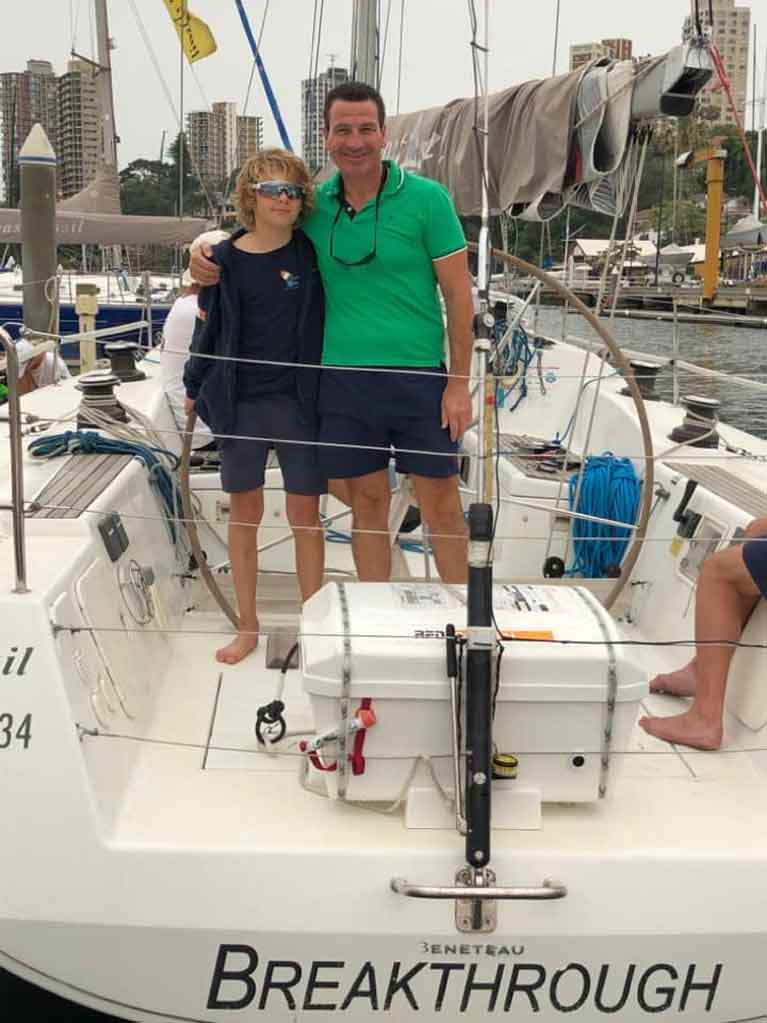 “Now it’s your turn, Dad”. The new Sydney Sailing Optimist Champion Rocco Wright with his father Darren on the First 40 HYC Breakthrough, which will compete in the 75th Rolex Sydney Hobart Race next Thursday. The rules of the RSHR stipulate that crew members must be at least 18 years old, so Rocco won’t be able to help the oldies with their challenge.
“Now it’s your turn, Dad”. The new Sydney Sailing Optimist Champion Rocco Wright with his father Darren on the First 40 HYC Breakthrough, which will compete in the 75th Rolex Sydney Hobart Race next Thursday. The rules of the RSHR stipulate that crew members must be at least 18 years old, so Rocco won’t be able to help the oldies with their challenge.
That said, HYC Breakthrough’s realise that they’re up against 163 other boats which include some of the best racing machines in the world, sailed by superb crews whose motivation to do will has been ratcheted up even further by this 75th anniversary special. By next Tuesday, the dust and smoke may not have settled, but at least the RSHR fleet’s departure from it will have come much nearer, so we’ll take a look then at how things are shaping up before disappearing into Christmas, from which next day a very handy escape hatch can be found with the RSHR 2019 Race Tracker.
Meanwhile, here’s the vid which gets the race’s flavour when the going is good:



























